$nicolasdelaroca text (213) 269-2439

Female Piercing infomation that you should know
Vulva Piercings
![]()
Genital piercings are unique because there is potential to directly affect your sexual pleasure. A poorly placed piercing can result in a missed opportunity for enhancement. Worse, a negative experience could cause you to suffer unnecessary pain, and a loss of sensation, either temporary or permanent. There are many nerve endings in small structures in this region so it is not an area with which to take risks.
Unfortunately, many piercers have NO specific training in genital piercings whatsoever! As an expert on the subject, and one who offers piercing problem consultations, I have bad news: a large percentage of genital piercings I see are improperly placed, often dangerously so.
Because of variations in anatomy and personal preferences for sexual stimulation, each piercee must be evaluated (and even counseled) on an individual basis before deciding on a genital piercing. Page through my blog posts to read about one bad genital piercing after another. It will scare you—and it should, so you will educate yourself to make sure you get a safe, successful piercing.
Note also that there is a great deal of confusion about the terminology. The vague terms "genital piercing" and "vaginal piercing" don't really say anything about a specific location for jewelry. More accurately, they should be called "vulva piercings."
Some piercees confuse "clit piercings" with clitoral hood piercings, which are very different! Unfortunately, a shocking number of piercers do too!!! One variety of hood piercing is expected to provide added stimulation, and another type is usually just ornamental. Three primary hood piercings are done: VCH, HCH, and triangle piercings. All of these and more are addressed below, as is the rare clitoris piercing.
There's a lot to know, so do your homework!
- VCH PIERCING
The Vertical Clitoral Hood (VCH) is by far the most popular female genital piercing for several reasons. As the name describes, the piercing is placed in the same direction that women’s genitals are formed, so the jewelry rests between the legs without stress or irritation. VCH PIERCING
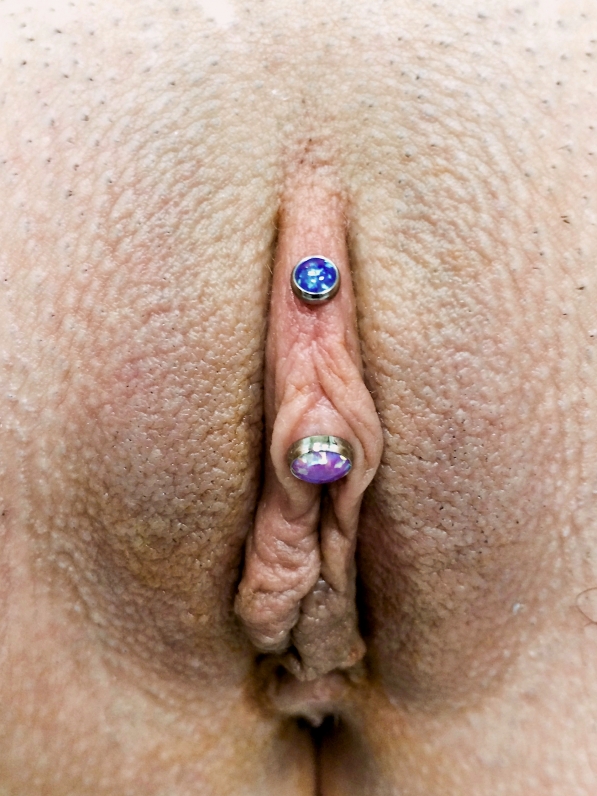
The Vertical Clitoral Hood (VCH) is by far the most popular female genital piercing for several reasons. As the name describes, the piercing is placed in the same direction that women’s genitals are formed, so the jewelry rests between the legs without stress or irritation. The majority of women are anatomically suited, with a hood (prepuce--the protective fold of hood tissue above the clitoris, analogous to the foreskin), in which jewelry can safely and comfortably be worn. And, importantly, many women find the VCH to be enjoyable and stimulating during sexual activities.
GENERAL INFORMATION
Women of all types, from sorority sisters to empty-nest retirees, are getting VCH piercings. It is not only for alternative individuals; numerous women who have no other body art wear this piercing. It is suited to any woman who wants to explore new avenues of erotic sensation, if she is anatomically built for it. It is liberating and stimulating as well as appealing and inspiring. The momentary pinch and quick, easy healing period are a small price to pay for the pleasure you can derive.
Dr. Vaughn Millner and associates at the University of South Alabama conducted a research study on VCH piercings as they relate to female sexual satisfaction. The results led to the following statement: “In this exploratory study, we identify a positive relationship between vertical clitoral hood piercing and desire, frequency of intercourse and arousal.” These encouraging findings were published in the prestigious (and conservative) American Journal of Obstetrics and Gynecology!
I've had clients tell me that following a VCH piercing they'd become multi-orgasmic, and others became able to climax from intercourse who couldn't previously.
Healing Time3-4 months or longer.
TRIANGLE PIERCING
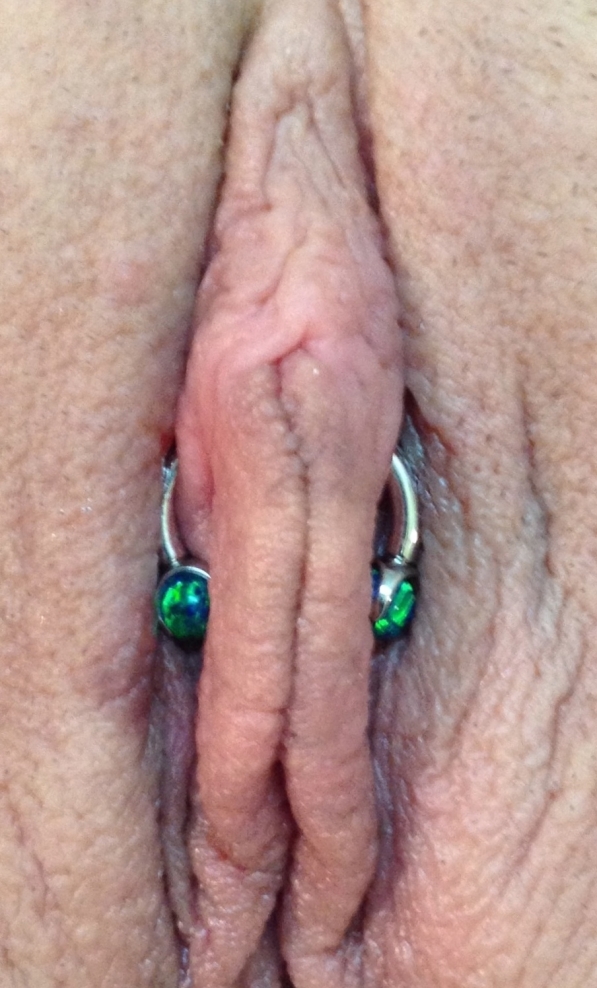
The triangle piercing is a modern innovation, first performed in the early 1990s. The piercer who invented it left the industry shortly thereafter, and I took over perfecting and popularizing this amazing, functional piercing.
The triangle is a horizontal piercing just underneath (not through!) the shaft of the clitoris, at the base of the hood. The stimulation from this piercing comes from added sensation behind your clitoris. This is quite unlike the other genital piercings, such as the popular VCH, which contacts the clitoris from the front.
GENERAL INFORMATION
The triangle is a very advanced piercing because it is placed largely by feel in an area where unfortunate and unacceptable damage could be done if a mishap occurs. Scrutinize the qualifications of any piercer who is under consideration to perform your triangle. Find out exactly where and how they learned to do this particular piercing and how many they have done. If you aren’t thoroughly impressed with a piercer's training and experience, keep looking. I frequently see terribly botched "triangle" piercings. Some images are below.
The triangle is one of my specialties (surely I've done more of them than any other piercer on the planet) and it is one of my favorite piercings to perform.
Many people ask whether a Vertical Clitoral Hood (VCH) or a triangle is the most stimulating piercing, but the truth is that they are completely different. Lots of piercees get one of each. If you are built for and interested in both, the VCH is an excellent introduction to genital piercing because it is fast and easy to heal as well as rewarding. The triangle is sometimes described as a more intense piercing, and it does have a longer healing time, so previous experience with genital piercing is helpful but in no way mandatory. Wearing both a VCH and a triangle creates a titillating sandwich: your sensitive clitoris is surrounded by jewelry, front and back.
I have had more than one client confide that they'd never (ever) had an orgasm in their entire twenty-plus years, until after I performed their triangle piercings! Since the partners and sexual activities were the same as pre-piercing, the triangle piercing obviously made all the difference. Knowing that triangle piercings I've performed have cured primary anorgasmia more than once totally validates my life’s work. No piercer can make promises, but if you're anatomically suited, and interested in the piercing, it is certainly worth a try!
Healing Time3-4 months or longer.
PLACEMENT
Optimal anatomy has a number of vital requirements for safety and success--all of which must be met for you to be a viable candidate:
• You need to have a protruding hood in the shape that I call a "hill," and it must be relatively symmetrical and of sufficient height. If your anatomy in that area is very narrow, small, or flat; or if you have a "valley" shape, in which your hood is concave, then you are not a candidate for this piercing. Some vulvas are built with a hill that is located within a valley. That is, the hood is large enough, and in a suitable configuration, but it is recessed within full outer labia. This type of build may be pierceable, but is considerably more challenging procedurally, and having the appropriate jewelry style and fit is especially critical.
• Your piercer must be able to identify and pinch behind your clitoral shaft (the cordlike nerve bundle) at the base of your hood, to slightly lift it away from your body. If this structure cannot be located or lifted, or if it rests deeper than the natural base of the hood, it is not possible to safely do the triangle piercing. See this page with more information and a video to clarify the location.
However, being able to find and pinch behind the shaft does not automatically make one pierceable for a triangle. The other anatomical considerations weigh equally on suitability. If you go in for a triangle and your piercer doesn't look for this structure--get up and leave!
• The base of the hood, where the triangle piercing should be placed, must be clear of blood vessels. It is fairly common for veins to be located in this region. Sometimes they are mobile and can safely be moved out of the way. But if a visible vessel is in the piercing's path and cannot be avoided, the triangle must not be pursued.
• Additionally, the surrounding region must be configured in a way that helps to stabilize the jewelry and hold it in place. If all else is suited but this requirement left unfulfilled, there's a likelihood of healing problems from excessive jewelry movement and twisting.
• Finally, some people are otherwise suited to the piercing, but their inner lips divide so high up at the top of the vaginal opening that the piercing would end up through two separate pieces of tissue there. For more on this, read about the biangle piercing.
Simply put, most vulvas are not anatomically suited to the triangle piercing. I'm able to honor only about 25-30% of the requests I get for it.
This is the one of the most commonly misplaced--and often horribly botched--piercings I see. (The other is the Vertical Clitoral Hood (VCH) piercing.) I often see "triangles" that are too high, and not located beneath the clitoral shaft, meaning, in essence, that they're unintentional Horizontal Clitoral Hood (HCH) piercings. I also see "triangles" that are positioned too low, and therefore too far away from the clitoral shaft to be stimulating. Sometimes these end up as two separate piercings of upper inner labia that are joined with a single piece of jewelry. Other times, I see them too far forward, and away from the base of the hood. These have been known to result in very painful and potentially damaging accidental piercings of the clitoral glans. Other times they pierce the clitoral shaft, which is also extremely painful, and could result in damage. I've seen a host of other "creative" so-called triangle placements that were unnecessarily agonizing for the piercees, and resulted in no enjoyment whatsoever.
The properly placed triangle and HCH piercings both pass through the same type—and even a similar amount—of hood tissue. However, for most piercees the triangle is the far more pleasurable option.
I'm happy to do an online anatomy consultation to determine if you appear to be a candidate for a triangle piercing, even if you plan to go to another piercer. Go here to see the photos I'll need to do your anatomy consult.
Note that I ALWAYS wear gloves for client contact! Images without gloves were sent to me for consultations, and are posted anonymously and with permission.
Showing "height of the hood" from the base to the edge, at the approximate location for a triangle piercing📷A low, shallow triangle with dot marked for appropriate placement, just beneath the clitoral shaft
Botched "triangle" piercing with arrows showing where it should have been located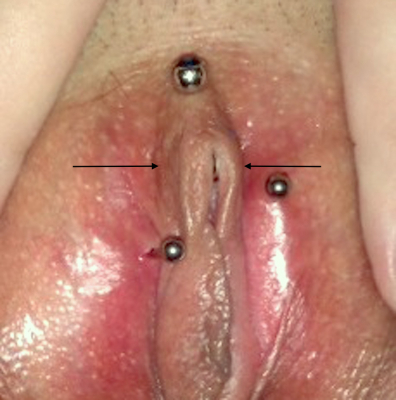
JEWELRY
Gold jewelry in VCH and "mini triangle" (petite build that is otherwise suited, but I used a 14 gauge circular barbell)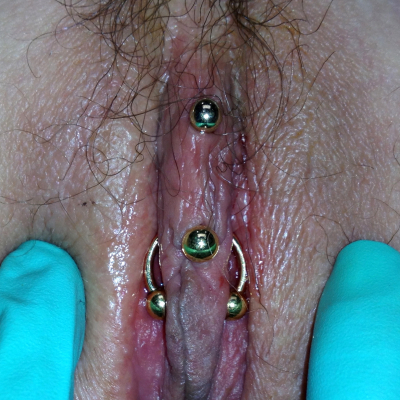 A triangle piercing and VCH with white opal jewelry, triangle untucked
A triangle piercing and VCH with white opal jewelry, triangle untucked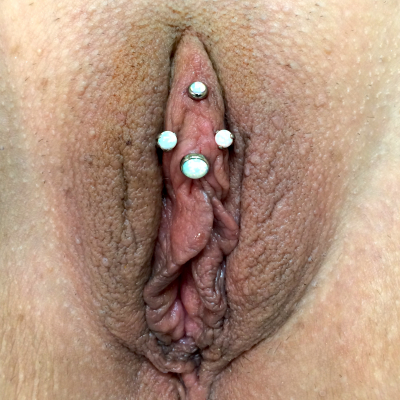 Triangle piercing stretched to 4 gauge with open steel circular barbell and gold balls
Triangle piercing stretched to 4 gauge with open steel circular barbell and gold ballsTriangle, VCH and inner labia piercings, with matching purple opals, triangle jewelry untucked
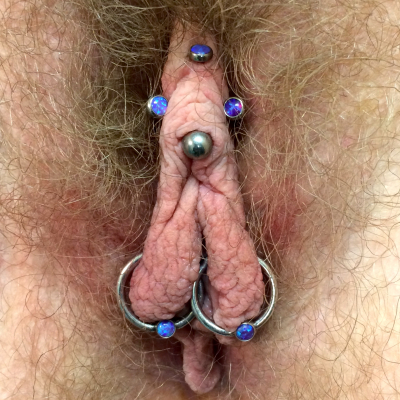 Triangle with gold circular barbell, Kellan Smith, The Powers That Be, Vancouver, WA https://www.thepowersthatbe.me/
Triangle with gold circular barbell, Kellan Smith, The Powers That Be, Vancouver, WA https://www.thepowersthatbe.me/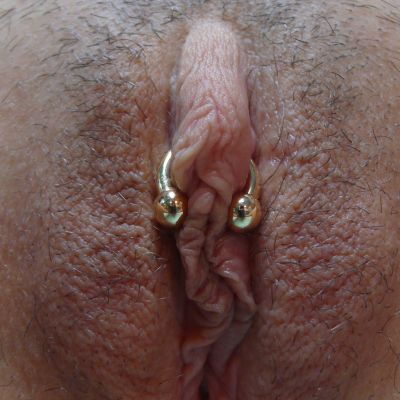
PROCEDURE
I use forceps on triangle piercings. First I perform tissue manipulation with my fingertips to lift and isolate the clitoral shaft, and make a bit of extra space at the base of the hood for the head of the clamps. This is extremely helpful to assure correct placement, and it makes it safer and easier to apply the forceps.
It is crucial that a constant hold is maintained to keep your clitoral shaft elevated while the tool is applied and the piercing is performed. If the cordlike structure drops back down, the piercing will not be in the correct position. Your clitoral shaft itself might get pierced, or you will end up with a low or deep hood piercing, but not a triangle. If your piercer does not seem concerned with keeping your clitoral shaft lifted, they probably do not know where a triangle is supposed to be placed!
Some piercers use "septum forceps," which have a short piece of receiving tube attached to the ends, and this can be a successful way to perform the triangle piercing.
I’ve had piercees comment that the triangle was easier than a nipple or hood piercing; but others find the experience more intense and draining. Still, when skillfully executed, the piercing will be momentary.
Learn which piercing(s) you are built for?
HEALING AND TROUBLESHOOTING
The triangle is the vulva piercing most likely to be a heavy bleeder, so don’t be surprised if you spot, or even flow, for several days afterward. It is prudent to wear at least a panty liner, if not a pad, for several days.
If you have an asymmetrical build or your jewelry is too wide to rest evenly between your legs, migration is to be expected. It may move just a little and then stop and settle, or you may need to abandon the piercing. Wearing the proper jewelry type and size is imperative for healing. If your C-ring or U-ring does not comfortably tuck close to your body, the ring, ball, or gap size may need to be adjusted. If your piercing is not healing well and you are not wearing a custom-widened circular barbell, then you should have one inserted.
Consider carefully a decision to remove triangle jewelry, even momentarily; reinserting it later is often impossible.
Because the piercing is located back against the body at the natural folds, evidence of an abandoned triangle is hardly visible.
THUNDER VOLT TATTOO & BODY PIERCINGS
59th and Harvard Blvd, LOS ANGELES CA 90047
ZELLE 213-269-2439 ZELLE
This website uses cookies.
We use cookies to analyze website traffic and optimize your website experience. By accepting our use of cookies, your data will be aggregated with all other user data.

Subscribe for 20% off for tattoo or piercing
$50 Deposit and $75 an hour plus tips
Search for Piercing Pricee Sheet.

